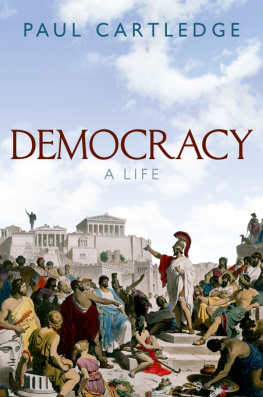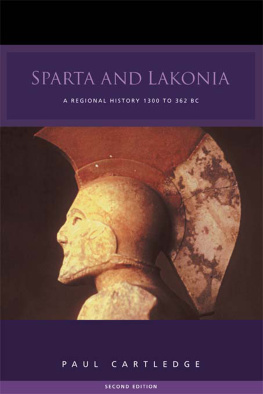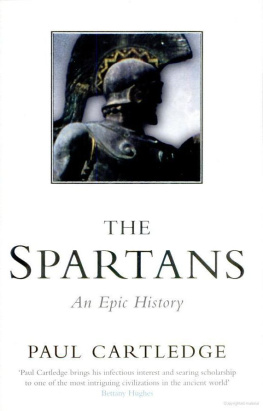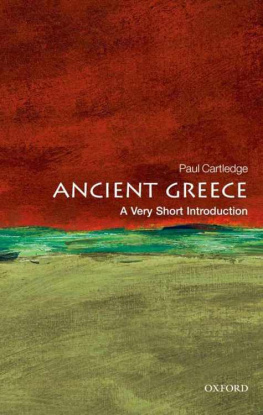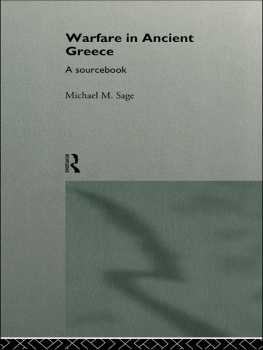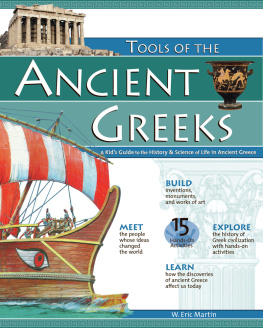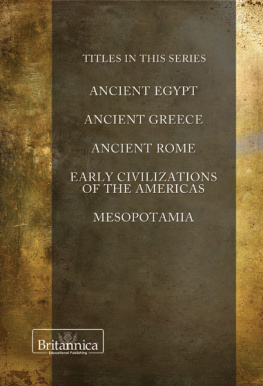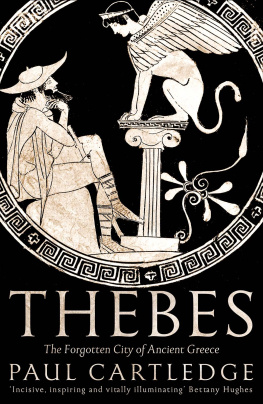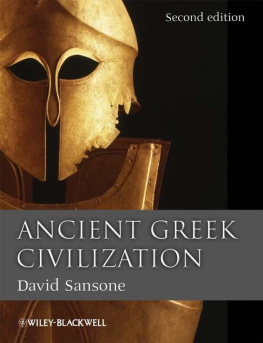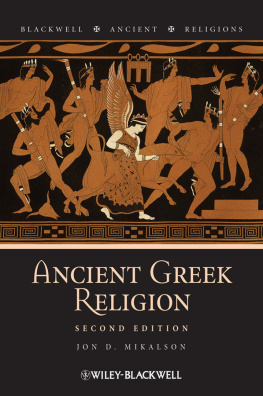ANCIENT GREECE
ANCIENT GREECE
A HISTORY IN ELEVEN CITIES

PAUL CARTLEDGE


Great Clarendon Street, Oxford OX 2 6 DP
Oxford University Press is a department of the University of Oxford. It furthers the Universitys objective of excellence in research, scholarship, and education by publishing worldwide in Oxford New York
Auckland Cape Town Dar es Salaam Hong Kong Karachi Kuala Lumpur Madrid Melbourne Mexico City Nairobi New Delhi Shanghai Taipei Toronto With offices in
Argentina Austria Brazil Chile Czech Republic France Greece Guatemala Hungary Italy Japan Poland Portugal Singapore South Korea Switzerland Thailand Turkey Ukraine Vietnam
Oxford is a registered trade mark of Oxford University Press in the UK and in certain other countries
Published in the United States by Oxford University Press Inc., New York
Paul Cartledge 2009
The moral rights of the author have been asserted Database right Oxford University Press (maker)
First published 2009
All rights reserved. No part of this publication may be reproduced, stored in a retrieval system, or transmitted, in any form or by any means, without the prior permission in writing of Oxford University Press, or as expressly permitted by law, or under terms agreed with the appropriate reprographics rights organization. Enquiries concerning reproduction outside the scope of the above should be sent to the Rights Department, Oxford University Press, at the address above
You must not circulate this book in any other binding or cover and you must impose the same condition on any acquirer
British Library Cataloguing in Publication Data Data available
Library of Congress Cataloging in Publication Data
Cartledge, Paul. Ancient Greece / Paul Cartledge. p. cm.
Includes bibliographical references and index. ISBN 9780199233380 (hardback : acid-free paper)
1. GreeceCivilizationTo 146 B.C. 2. Byzantine EmpireCivilization. I. Title. DF77.C34 2009
938dc22 2009026999
Typeset by SPI Publisher Services, Pondicherry, India Printed in Great Britain on acid-free paper by Clays Ltd., St Ives Plc
ISBN 9780199233380
1 3 5 7 9 10 8 6 4 2
To the Trustees
of the A. G. Leventis Foundation
PREFACE
It is very hard, in a short book, to do anything like full justice to an Ancient Greece that was a conglomerated civilization or culture of roughly 1,000 separate and often very distinct political entities at any one moment in ancient time, and that stretched at the limit from southern Spain to the Black Sea shore of modern Georgia. (The Fitzwilliam Museum in Cambridge in 2008 hosted an exhibition devoted to splendidly sophisticated, mainly Greek-made finds from graves in Vani, Georgia, associated with an in-house exhibition of coins from the Black Sea region generally.)
A Whos Who, a Glossary, and a Timeline have been included to enhance ease of quick reference, together with notes on the spelling of Greek words and names, and on Greek measures of money and distance. But I should also like to draw readers attention to The Cambridge Illustrated History of Ancient Greece. Like this book, the CIHAG combines thematic with chronological approaches, and social, economic, religious, and cultural with political, military, and diplomatic history, but in a format which, unlike the present volume, is very definitely not suitable for pulling out of a pocket to read on the train or bus or plane. I hope that it may be useful as a companion to readers of this book, as it has been to me in the writing of it.
ACKNOWLEDGEMENTS
I should like to thank again my collaborators on The Cambridge History of Ancient Greece: Sue Alcock (now of Brown University), Nick Fisher (University of Wales, Cardiff), Marilyn Katz (Wesleyan University), Edith Hall (now Royal Holloway University of London), Karim Arafat (Kings College London), Catherine Morgan (now Director of the British School at Athens), Lesley Dean-Jones (University of Texas at Austin), and Richard Buxton (Bristol University); and the other colleagues and friends, too, on the continent of Europe (especially in Greece), in Africa, in America North and South, in Australasia, and in Japan, who have in some way or other contributed to the text that follows. There are too many to name them all individually, but two do require special mention: Robert Garland (Colgate University) and Polly Low (University of Manchester), who both at extremely short notice read and commented expertly on an entire near-final draft. And I must not forget the Presss anonymous reader, who saved me from considerable embarrassment. Were it not for their kindness and collegiality, this book would have been even more imperfect than it is. I count myself exceedingly fortunate, too, to be writing at a time when the modern historiography of ancient Greece is experiencing something of a boom, and, not least, when outreach to wider publics than just ones fellow-specialists is considered a (pleasurable) duty rather than a luxury.
It is in that same spirit of striving for outreach that I was deeply honoured to have my personal chair in Cambridges Faculty of Classics endowed in perpetuity as the A. G. Leventis Professorship of Greek Culture (with effect from 1 October 2008). This book is one of the first fruits of that charity, and it is dedicated, in a spirit of ineffable kharis, to the Trustees of the A. G. Leventis Foundation.
CONTENTS
NOTE ON SPELLING OF GREEK NAMES/WORDS
By inclination I prefer to transliterate rather than anglicize ancient Greek names and words, but even I write Aeschylus and Thucydides, not Aiskhulos and Thoukudides. Here I have deviated from strict transliteration in various, not always consistent waysa truly British compromise (or muddle): thus, for example, Cnossos, not Knossos (transliteration), nor Cnossus (Latin). But one outstanding exception had to be madefor Byzantion (the city); this in order to avoid confusion with anglicized, Latinate Byzantium (either a civilization or an epochduring which Byzantion, as the city-name, got the works in favour of KonstantinoupolisConstantinople). Where I place a circumflex over the e or o of a transliterated ancient Greek word, that is to indicate, especially in cases where transliteration might lead to misunderstanding, that the vowel was longor big as the Greeks said: omicron = (literally) small o, mega = big o. Greek short e, epsilon, meant light e ; the long version was called ta.
GREEK MEASURES OF MONEY AND DISTANCE
I. MONEY
6 obols = 1 drachma
2 drachmas = 1 statr (literally balance)
100 drachmas = 1 mina (or mna) [the word is of Babylonian origin]
60 minas = 1 talent [also of Babylonian origin]
Note, first, that the value of coinsstruck in electrum, gold, silver, or bronze, from the later seventh century onwas a function of their weight, and that different cities operated different weight-standards, often those established by another city. Second, although it is not possible straightforwardly to translate ancient weights/values into modern currency equivalents, it may be helpful to bear in mind that the average rate of daily pay for a skilled craftsman varied during the fifth and fourth centuries BCE between 1 and 2.5 drachmas, and that rough parity was established between a daily craftsmans wage-rate and the pay given by democratic Athens to citizens for attendance at the Assembly between the 390s and 320s. The daily cost of living for a family of four in Athens at the end of the fifth century is estimated at between 2.5 and 6 obols. Third, small changefractions of silver obolswas in use by the end of the sixth century, struck by mints including those of Colophon, Aegina, Mende, and Abdera; it could be offered as payment for pots, legal fines, or fees for initiation into a religious cult. Much less valuable bronze coinage was not struck in quantity until the end of the fifth century, by which time an issue of gold coinage by a Greek city signified emergencyin sharp contrast to the Persian empire, where it constituted business as usual, and a powerful diplomatic as well as commercial instrument.
Next page


